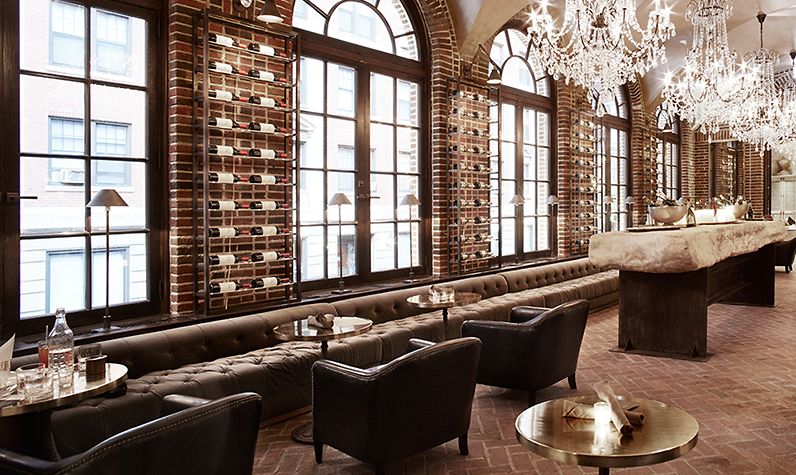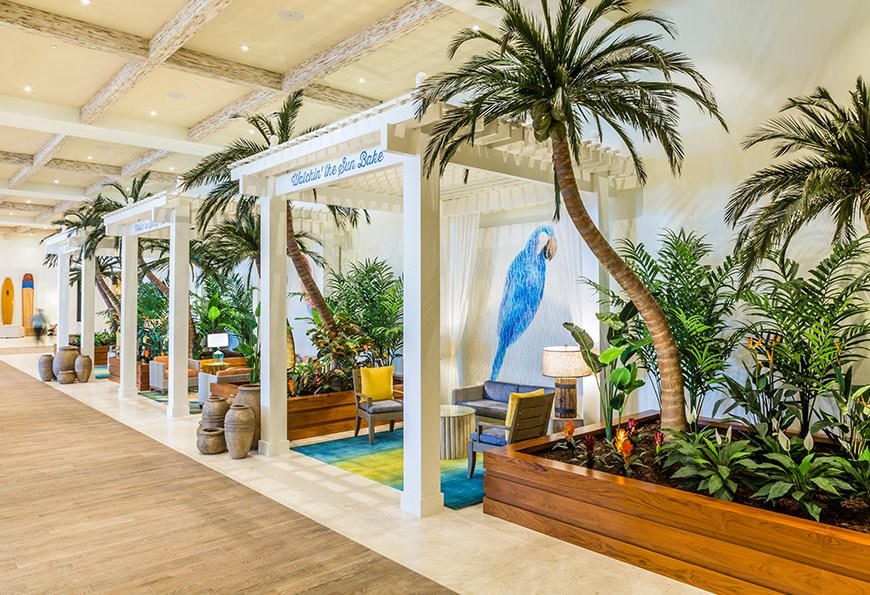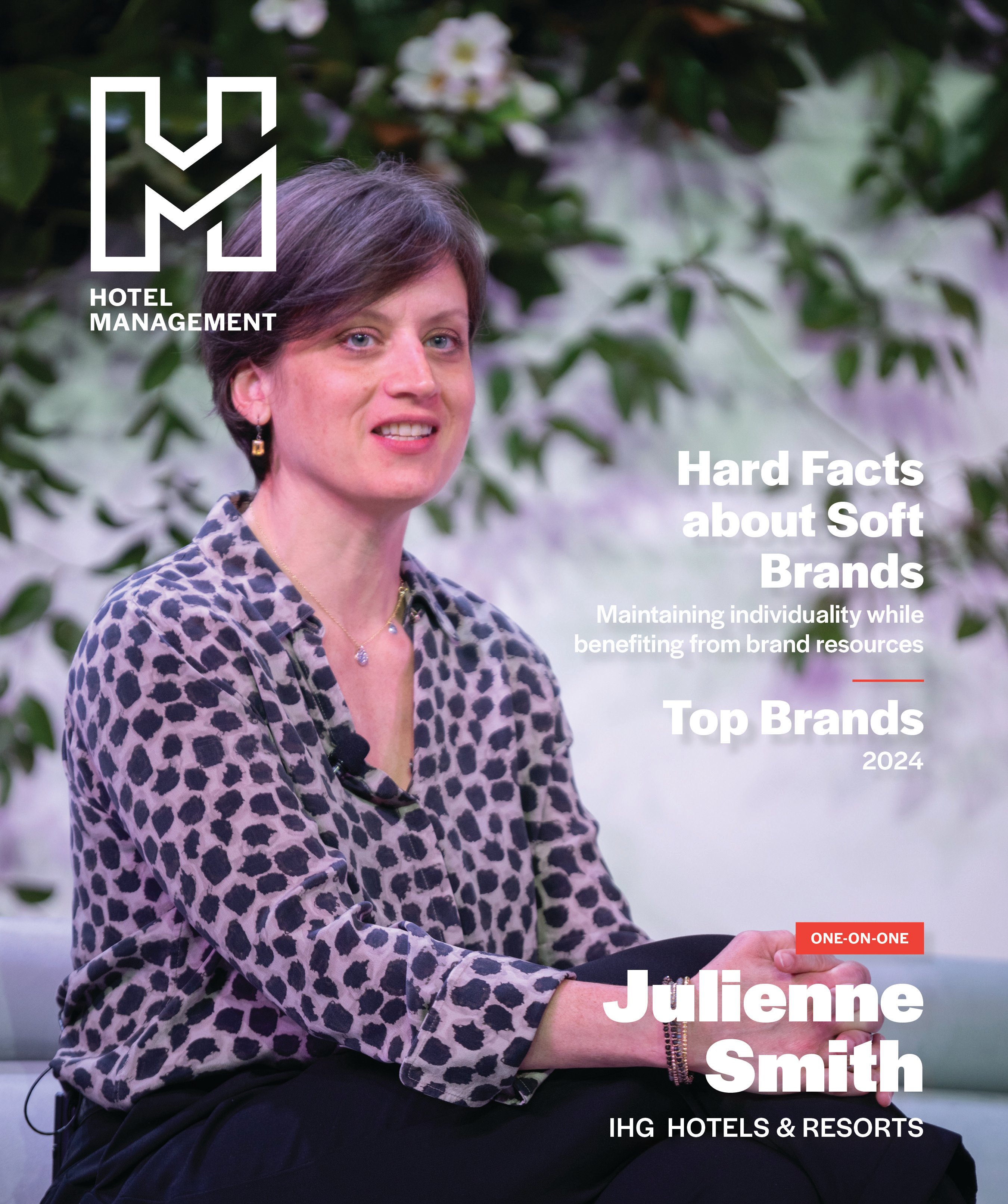The McBride Company has designed hospitality spaces under the Margaritaville, Four Seasons and Hard Rock banners. Jessica Lotner, a senior interior designer at the company, shared some insights into what hotel design elements will be hot this year—and beyond.
1. Colors that Pop
As recently as five to 10 years ago, Lotner said, neutral colors reigned supreme. Then, bit by bit, clients began asking Lotner’s team to inject color into spaces—what she describes as “stark minimalism with a twist.”
“With a neutral base, we’re infusing deep, saturated colors, creating bold, striking experiences in the space.” A primary reason for this, she said, is that as millennials choose hotels on sites like TripAdvisor, they seek out the most eye-catching pictures. With less brand loyalty than previous generations, these guests are opting for elements that photograph well. “Millennials are digital, so they want to share pictures. We’re providing them with something to photograph—something in lobby, a selfie they can share with friends.”
Beyond that, she said, many homes are decorated in neutral colors. “When they go to hotel with bold color, in their minds, it’s different. It’s fun, vivid, as opposed to their comfortable home.”
2. Warmer Metals, Rougher Luxury
Over the last year, Lotner said, “cool” metallic tones have given way to golds, bronzes and warmer metals. “Prepare to start seeing even darker metals, such as dark bronze, incorporated into interiors,” she said. “The great thing about is is that it hides imperfections and ages well.”
This new aesthetic, which she describes as “rough luxe,” is a reaction to the “polished, glossy, flawless” spaces that have been trendy for years. “People love the emergence of rough luxe,” Lotner said. “It shows the provenance and the history of the space. In imperfections, you find luxury. If something has history, a story to it, that brings luxury to it.”

For designers, she said, the “rougher” styles can be fun, giving them a chance to play with hammered metals and warmer tones. “It shows the artist’s touch and it ages beautifully,” she said. “It’s okay to have a patina or blacker, worn-down areas. It sets a tone in some minds that it’s okay not to be perfect. There’s something lovely about it.” Lotner recommends using these metals on door hardware or dividing screens, and even with lighting fixtures. “Lighting is the jewelry in a space,” she said. “It’s the voila moment. It sets the tone. By doing that with warm metals and lighting, you can play with textures.” We’re wrapping warm metals with rope or textures on glass--netting. Sets the tone.
3. Steampunk Enters the Mainstream
Steampunk—the combination of Victorian fashion and modern technology, like putting the inner workings of an elegant clock on display—has gone from niche to nouvelle. With Cirque du Soleil and fashion shows including elements of steampunk, the trend is going from one art medium to next. “Now, it’s kind of a subcategory because of rough luxe,” Lotner said.
In terms of design, hotels can include steampunk elements with warmer metals, leather, exposed brick and “beat-up” decor. “You’ll see elements of it in light fixtures and furniture—in the hardware, there’ll be nuts and bolts.” Artifacts that set the stage to tell a story will be used as decorative touches—look for maps and globes, sepia-toned photos and object-oriented decor. “Accessories that set the decor are a cue to someone that they’re in a unique space,” Lotner said. Major designers are also incorporating steampunk elements, she said. “Restoration Hardware seems like it’s greatly influenced by steampunk. It’s mainstream, but some elements are in entire lines.”
4. From Outdoor to Indoor
Outdoor elements are becoming increasingly popular in interior design, from upholstery to wood finishes and—of course—living plants used as decor.
Philippe Starck started the trend in the 1990s, Lotner said. “I remember going on the deck of a hotel and they had these oversized potted plants. He introduced green walls into the space. Since then, people are having fun with that idea, especially in cities.” Greenery can go a long way in giving a hotel a sense of space, she said, and incorporating outdoor elements helps guests feel like they’re truly in a city.
Lotner worked on the Margaritaville Hotel in Hollywood, Fla., and at the time of the interview was working on another in Orlando. “That lobby is a great example,” she said. “When you walk in the door, the limestone floor has embedded shells. We organized the layout of lobby so that there are nooks with cabanas. And within those cabanas, we put hanging sofas. It’s organized with planters that form the furniture plan. You walk around the planters filled with all sorts of plants and palm trees. Immediately, somebody feels like they’re on vacation in a tropical place, and they’re relaxed. They can put their feet up on the sofa. You see it as people walk through the space. They’re leaning back, enjoying themselves. It’s an inexpensive but effective way to set the stage.”

Hanging screens with cabanas in a lobby or using outdoor lanterns can set a tone, Lotner said. “Outdoor fabrics are fabulous these days. The textures give a casual elegance.” With guests increasingly concerned about how eco-friendly their hotels are, having live plants in the decor sends a message of environmental awareness.
5. The Writing is Still on the Wall
Whether it’s text embossed on the floor of a hotel lobby or a menu printed on the wall of a restaurant, more designers will incorporate text into their hotel designs.
“It’s a way to get people to stop and pause,” Lotner said. In the Margaritaville hotels, song lyrics are used as decor. “Take a little line of a song, put it on a wall and it becomes a message. It’s fun and playful but eye-catching—and almost a moment of self-reflection. It’s the simplest way of creating an eye-catching design element. I’ve seen restaurants where it’s an entire wall with exposed brick, and one line of text. It makes the space.
“I was in a restaurant where the bar stools—these old, cool, rough wood bar stools—on the top of seat had ingrained the words, ‘have a seat.’ That detail made the whole space. It brought something playful and whimsical. It’s a fun design element.”
For a designer, she added, incorporating text into the decor can bring the entire project full-circle. When designers begin to imagine what a space can look like, she said, they “infuse” themselves in research. A poem or a song lyric can be an inspiration from the get-go, and can convey the hotel’s message to its guest. “It goes back to the message of what you want people to experience,” she said. “Think about what that message is—but do it with a twist, so it isn’t beating someone over the head. Edit it down to the essence.”

